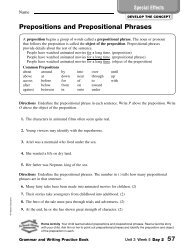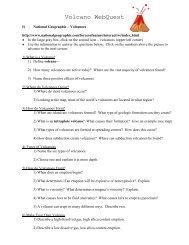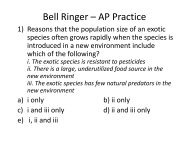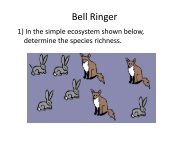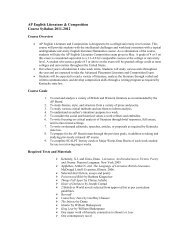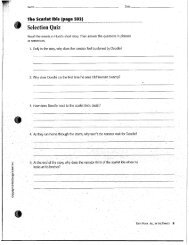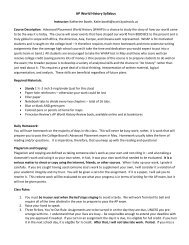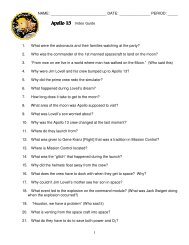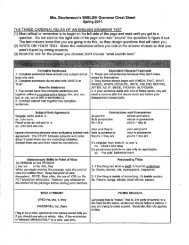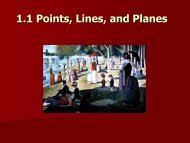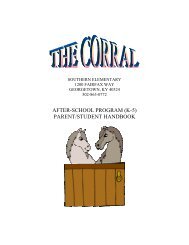Geometry
Geometry
Geometry
Create successful ePaper yourself
Turn your PDF publications into a flip-book with our unique Google optimized e-Paper software.
2.3 Conditional Statements
Objectives<br />
• Analyze statements in if-then form.<br />
• Write the converse, inverse, and contrapositive<br />
of if-then statements.
If-Then Statements<br />
• A conditional statement is a statement that can be<br />
written in if-then form.<br />
Example: If an animal has hair, then it is a mammal.<br />
• Conditional statements are always written “if p, then q.”<br />
The phrase which follows the “if” (p) is called the<br />
hypothesis, and the phrase after the “then” (q) is the<br />
conclusion.<br />
• We write p q, which is read “if p, then q” or<br />
“p implies q.”
Example 1a:<br />
Identify the hypothesis and conclusion of the<br />
following statement.<br />
If a polygon has 6 sides, then it is a hexagon.<br />
If a polygon has 6 sides, then it is a hexagon.<br />
hypothesis<br />
conclusion<br />
Answer: Hypothesis: a polygon has 6 sides<br />
Conclusion: it is a hexagon
Example 1b:<br />
Identify the hypothesis and conclusion of the<br />
following statement.<br />
Tamika will advance to the next level of play if she<br />
completes the maze in her computer game.<br />
Answer: Hypothesis: Tamika completes the maze in her<br />
computer game<br />
Conclusion: she will advance to the next level<br />
of play
Your Turn:<br />
Identify the hypothesis and conclusion of each<br />
statement.<br />
a. If you are a baby, then you will cry.<br />
Answer: Hypothesis: you are a baby<br />
Conclusion: you will cry<br />
b. To find the distance between two points, you can use<br />
the Distance Formula.<br />
Answer: Hypothesis: you want to find the distance<br />
between two points<br />
Conclusion: you can use the Distance Formula
If-Then Statements<br />
• AS we just witnessed, often conditionals are not written<br />
in “if-then” form but in standard form. By identifying<br />
the hypothesis and conclusion of a statement, we can<br />
translate the statement to “if-then” form for a better<br />
understanding.<br />
• When writing a statement in “if-then” form, identify the<br />
requirement (condition) to find your hypothesis and the<br />
result as your conclusion.
Example 2a:<br />
Identify the hypothesis and conclusion of the<br />
following statement. Then write the statement<br />
in the if-then form.<br />
Distance is positive.<br />
Sometimes you must add information to a statement.<br />
Here you know that distance is measured or determined.<br />
Answer: Hypothesis: a distance is determined<br />
Conclusion: it is positive<br />
If a distance is determined, then it is positive.
Example 2b:<br />
Identify the hypothesis and conclusion of the<br />
following statement. Then write the statement<br />
in the if-then form.<br />
A five-sided polygon is a pentagon.<br />
Answer: Hypothesis: a polygon has five sides<br />
Conclusion: it is a pentagon<br />
If a polygon has five sides, then it is<br />
a pentagon.
Your Turn:<br />
Identify the hypothesis and conclusion of each<br />
statement. Then write each statement in if-then form.<br />
a. A polygon with 8 sides is an octagon.<br />
Answer: Hypothesis: a polygon has 8 sides<br />
Conclusion: it is an octagon<br />
If a polygon has 8 sides, then it is an octagon.<br />
b. An angle that measures 45º is an acute angle.<br />
Answer: Hypothesis: an angle measures 45º<br />
Conclusion: it is an acute angle<br />
If an angle measures 45º, then it is an acute<br />
angle.
If–Then Statements<br />
• Since a conditional is a statement, it has a truth value.<br />
The conditional itself as well as the hypothesis and/or<br />
conclusion can be either true or false.
Example 3a:<br />
Determine the truth value of the following statement<br />
for each set of conditions. If Sam rests for 10 days,<br />
his ankle will heal.<br />
Sam rests for 10 days, and he still has a hurt ankle.<br />
The hypothesis is true, but the conclusion is false.<br />
Answer: Since the result is not what was expected, the<br />
conditional statement is false.
Example 3b:<br />
Determine the truth value of the following statement<br />
for each set of conditions. If Sam rests for 10 days,<br />
his ankle will heal.<br />
Sam rests for 3 days, and he still has a hurt ankle.<br />
The hypothesis is false, and the conclusion is false. The<br />
statement does not say what happens if Sam only rests<br />
for 3 days. His ankle could possibly still heal.<br />
Answer: In this case, we cannot say that the statement<br />
is false. Thus, the statement is true.
Example 3c:<br />
Determine the truth value of the following statement<br />
for each set of conditions. If Sam rests for 10 days,<br />
his ankle will heal.<br />
Sam rests for 10 days, and he does not have a hurt<br />
ankle anymore.<br />
The hypothesis is true since Sam rested for 10 days, and<br />
the conclusion is true because he does not have a hurt<br />
ankle.<br />
Answer: Since what was stated is true, the conditional<br />
statement is true.
Example 3d:<br />
Determine the truth value of the following statement<br />
for each set of conditions. If Sam rests for 10 days,<br />
his ankle will heal.<br />
Sam rests for 7 days, and he does not have a hurt<br />
ankle anymore.<br />
The hypothesis is false, and the conclusion is true. The<br />
statement does not say what happens if Sam only rests<br />
for 7 days.<br />
Answer: In this case, we cannot say that the statement<br />
is false. Thus, the statement is true.
Your Turn:<br />
Determine the truth value of the following statements<br />
for each set of conditions. If it rains today, then<br />
Michael will not go skiing.<br />
a. It does not rain today; Michael does not go skiing.<br />
Answer: true<br />
b. It rains today; Michael does not go skiing.<br />
Answer: true<br />
c. It snows today; Michael does not go skiing.<br />
Answer: true<br />
d. It rains today; Michael goes skiing.<br />
Answer: false
If – Then Statements<br />
• From our results in the<br />
previous example we can<br />
construct a truth table<br />
for conditional<br />
statements. Notice that a<br />
conditional statement is<br />
true in all cases except<br />
when the conclusion is<br />
false.<br />
p q p q<br />
T T T<br />
T F F<br />
F T T<br />
F F T
Converse, Inverse, and Contrapositive<br />
• From a conditional we can also create additional<br />
statements referred to as related conditionals. These<br />
include the converse, the inverse, and the<br />
contrapositive.
Converse, Inverse, and Contrapositive<br />
Statement Formed by Symbols Examples<br />
Conditional<br />
Converse<br />
Inverse<br />
Contrapositive<br />
Given an<br />
hypothesis and<br />
conclusion<br />
Exchange the<br />
hypothesis and<br />
conclusion<br />
Negate both the<br />
hypothesis and the<br />
conclusion<br />
Negate both the<br />
hypothesis and<br />
conclusion of the<br />
converse<br />
p q If 2 angles have the same<br />
measure, then they are<br />
congruent.<br />
q p If 2 angles are congruent, then<br />
they have the same measure.<br />
~p ~q If 2 angles do not have the<br />
same measure, then they are<br />
not congruent.<br />
~q ~p If 2 angles are not congruent,<br />
then they do not have the<br />
same measure.
Converse, Inverse, and Contrapositive<br />
• Statements that have the same truth value are said to be logically<br />
equivalent. We can create a truth table to compare the related<br />
conditionals and their relationships.<br />
Conditional Converse Inverse Contrapositive<br />
p q p q q p ~p ~q ~q ~p<br />
T T T T T T<br />
T F F T T F<br />
F T T F F T<br />
F F T T T T
Example 4:<br />
Write the converse, inverse, and contrapositive of the<br />
statement All squares are rectangles. Determine<br />
whether each statement is true or false. If a statement<br />
is false, give a counterexample.<br />
First, write the conditional in if-then form.<br />
Conditional: If a shape is a square, then it is a rectangle.<br />
The conditional statement is true.<br />
Write the converse by switching the hypothesis and<br />
conclusion of the conditional.<br />
Converse: If a shape is a rectangle, then it is a square.<br />
The converse is false. A rectangle with = 2<br />
and w = 4 is not a square.
Example 4:<br />
Inverse:<br />
If a shape is not a square, then it is not a<br />
rectangle. The inverse is false. A 4-sided<br />
polygon with side lengths 2, 2, 4, and 4 is<br />
not a square, but it is a rectangle.<br />
The contrapositive is the negation of the hypothesis and<br />
conclusion of the converse.<br />
Contrapositive: If a shape is not a rectangle, then it is<br />
not a square. The contrapositive is true.
Your Turn:<br />
Write the converse, inverse, and contrapositive of the<br />
statement The sum of the measures of two<br />
complementary angles is 90. Determine whether each<br />
statement is true or false. If a statement is false, give<br />
a counterexample.<br />
Answer: Conditional: If two angles are complementary,<br />
then the sum of their measures is 90; true.<br />
Converse: If the sum of the measures of two<br />
angles is 90, then they are complementary;<br />
true.<br />
Inverse: If two angles are not complementary,<br />
then the sum of their measures is not 90; true.<br />
Contrapositive: If the sum of the measures of<br />
two angles is not 90, then they are not<br />
complementary; true.
Assignment<br />
• <strong>Geometry</strong>:<br />
Pg. 78 – 79<br />
#16 – 43



